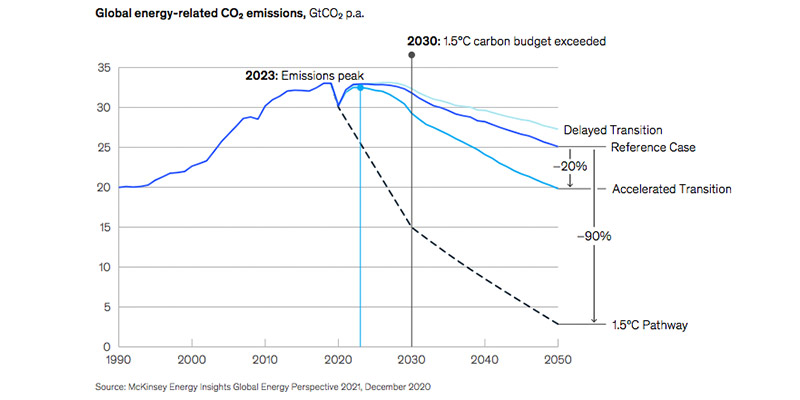You might be interested in
News
ASX Small Caps Lunch Wrap: Inflation a little higher than expected, but then so is the ASX
Mining
FMG Results: Fortescue stunned by 'mind-blowing' China renewables rollout, says steel demand is diversifying
Mining
Energy
Global CO₂ emissions will peak in 2023, McKinsey said.
But the consulting firm’s view is that on current trends, the world is veering well off course from a pathway to cap global warming at 1.5°C by 2050.
McKinsey’s base case is for emissions to peak in the next two years, before steadily declining by around 25 per cent through to the middle of the century.
However, to limit global warming to 1.5°C by that time, emissions will have to fall to less than five gigatonnes per annum.
Even if the world adopts McKinsey’s “accelerated transition” pathway, it still won’t get close to that number:

Emissions would have to fall at the same rate they did in 2020 — when the global economy briefly ground to a halt — for the next 30 years to meet the sub-1.5°C target, McKinsey said.
But in their base-case scenario, the analysts said fossil fuels will “continue to play an important role in energy systems”.
While coal use peaked in 2014 and is now on the decline, McKinsey forecast oil use to peak by 2029, while gas use will peak in 2037.
Oil demand in advanced economies such as the US and Europe has already peaked, with demand over the next decade set to be underpinned by emerging economies.
However, global oil use is still only expected to fall by around 10 per cent through to 2050.
“Despite the increased momentum toward decarbonisation, many governments still need to translate ambitious targets into specific policies,” the analysts said.
Particularly crucial is what happens over the next decade, when global emissions will need to halve on the way to the net-zero target.
Within that rapid change, McKinsey flagged green hydrogen as the renewable power source which has the capacity to “change the energy landscape” through to 2036.
Last month, mining billionaire Andrew Forrest’s Fortesce Metals Group (ASX:FMG) laid out plans for a number of green hydrogen projects, with its first investment decision scheduled for later this year.
ALSO READ: ‘Complex transition’: 4 experts weigh in on Australia’s path to a clean energy future
The US and the European Union have both targeted net-zero emissions by 2050, while Australia’s government is moving towards the same target.
“Without further decarbonisation policies, more than half of all global energy demand comes from fossil fuels by 2050,” McKinsey said.
Net-zero is the pathway required to 1.5°C warming cap, but for now, “not enough is being done”.